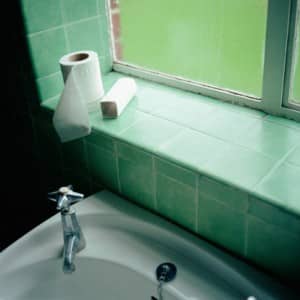 Between Tiles:
Between Tiles:
Ceramic tile is often installed in public and private restrooms due to its aesthetic qualities. It is also easier to clean and maintain because, unlike VCT (vinyl composition tile), there is no need to strip and recoat. Simply mop or wipe the tile and repeat indefinitely. Unfortunately, the glue that holds ceramic tile together is grout.
Grout starts out as clean as the white gown of a soloist in a boy’s choir, but just as that same boy is bound to roll around in the dirt, staining his gown, so too will your grout become a blackened, sticky mess if you don’t have a proper maintenance program. In this article we will discuss the daily, routine, and restorative methods for cleaning grout. Implementing these methods will improve both the odor and overall appearance of your restroom, thus reducing the total number of complaints by customers and/or employees of the organization. These methods will also reduce your total cost to maintain the restrooms and all but eliminate any need for odor masking products.
All the methods discussed below work off an assumption that the grout in question is porous in nature. (Sealed grout is no longer porous because grout sealer works as a gap filler. No gaps means no pores.) It is the pores within grout that harbor bacteria and germs. To remove the bacteria and germs from these pores it is first necessary to bring them to the surface through use of a displacement process: steam, peroxide, or bristle.
Restorative Cleaning:
We will start with restorative cleaning, which is to say that unless this is new construction you will most likely be working with grout that is already discolored, completely blackened, or showing signs of mold and mildew. The easiest method for checking the overall condition of your grout is to give it an eyeball test. How does the color of the floor grout compare to the grout you find on the wall? Or check less traveled areas and compare that grout color to the grout color next to a bathroom stool or underneath a urinal fixture. If it is gray in color (or “darker” for colored grout) and spotty in appearance, chances are you do not need to worry about restorative cleaning. Skip to daily cleaning.
However, if the grout in question is black, slick, or discolored, you will need to proceed with a rather time consuming, but necessary restorative cleaning process. (Note: If the grout is chipped or missing you will need to make repairs prior to proceeding with any cleaning measures.)
Steam Cleaning: This is excellent technology and highly effective. Nevertheless, cleaning your grout lines with a steam cleaner is likened to mowing your lawn with a pair of scissors. And, yes, that is the suggested rate of speed. Do this one time and you will understand why daily cleaning activities are so important.
Directions: Attach a cloth (preferably white) to the end of your steel wire brush which should then be attached to either a hand tool or extended wand. (These tools are included with most steam machines.) Apply steam through the cloth and absorb residue by slowly dragging the cloth-bound tool over the grout. Shift the cloth as-needed or as the cloth becomes heavily soiled.
Daily Cleaning:
Use a peroxide based cleaner like Oxy Care on walls, counter tops, and floors. The bubbling action of peroxide works to loosen soil within grout pores, bringing it to the surface for easy removal; it also “whitens” the grout over time. Whatever cleaner you are currently using should be replaced with a peroxide cleaner, whether in spray and wipe applications or as a mopping agent.
Routine Cleaning:
This can be defined as once per week or month or quarter depending upon the amount of soil or traffic within a given restroom. Regardless, use a peroxide based cleaner in combination with either a scrub or grout brush. The additional agitation will remove any build-up and prevent the need for restorative cleaning.





